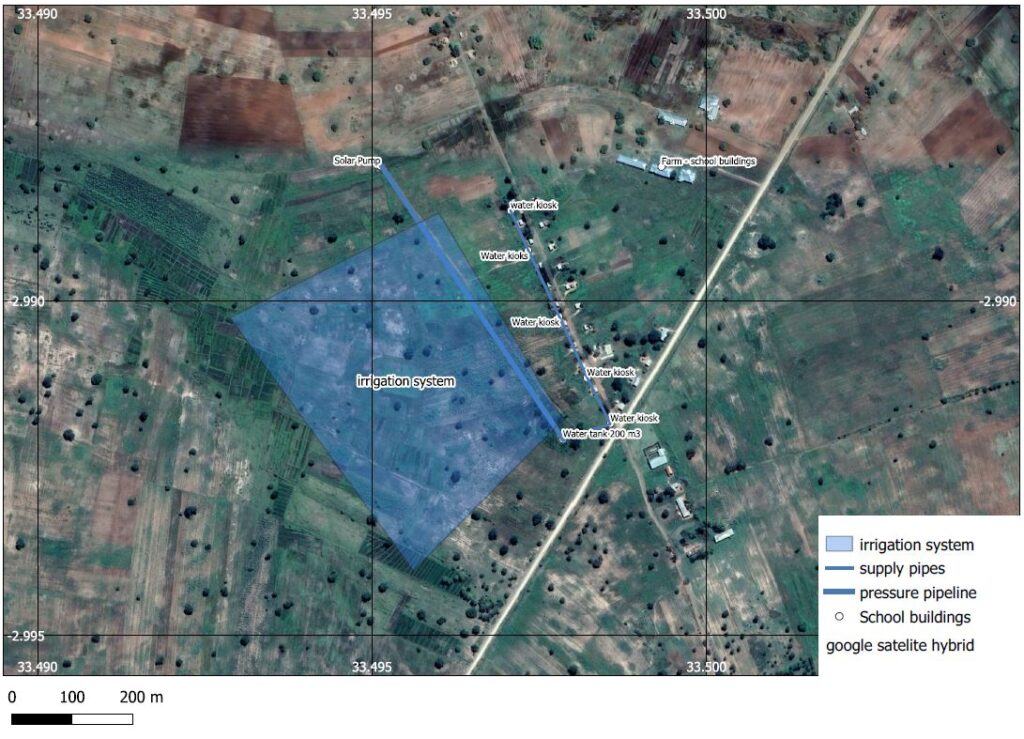Our previous “Basic Needs” projects together with the Technical University of Applied Sciences Lübeck
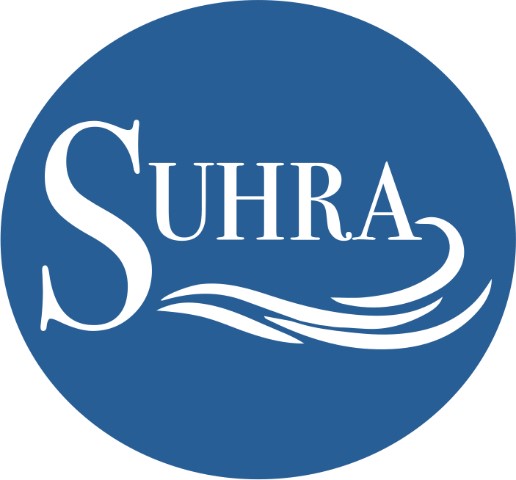
Overview
• 2009: Comprehensive Determination of the Basic Needs in the Field of Urban Hygiene
• 2011: Workshops on Hygiene, Water Treatment, Environmental Protection
• 2011: Construction of Clay Cooker
• 2015: Workshops on Hygiene, Water Treatment, Environmental Protection
• 2015: Construction of Clay Cooker
• 2015: Construction of a Separation Toilet
• 2015: Construction of Drinking Water Wells
• 2018-2019: Water for Malya
History
Due to the intensive cooperation between Luther-Melanchthon church parish and the Laboratory for Urban Water Management and Waste Management at the Technical University of Applied Sciences Lübeck (LSA for short), a voluntary working group „Basic Needs“ was formed at the LSA, which coordinates the technical aspects of the cooperation. The working group consists of employees and students (also former) of the LSA and other volunteers, some of whom are also members of the Tanzania group in Luther-Melanchthon church parish. Since the social and technical integration of the projects in Tanzania is organized and supervised by the partners of Angasah church parish, the project coordination on the German side is also carried out by the church parish. In 2015, two students alternating members of the Basic Needs group were working on-side for three months. A separating toilet and several clay cooker places were built specifically to improve the basic needs of the rural population in the villages. The first separation toilet was initially built for demonstration purposes at a school for around 500 students. In addition, several hygiene and education workshops were held in schools and in the villages to explain to people how the separating toilet works and other hygienic aspects. For this purpose, a webpage for the 2015 campaign was set up on the “betterplace.org” internet platform:
Detailed Project Description
Sanitation
Determination of basic needs in settlement hygiene, 2009
Contact: Marleen Krugmann
120 family interviews were conducted in Igoma, as well as the sub-urban villages of Kissesa, Ihayabuyaga and Ikengele. 43 families in Ikengele, 40 in Ihayabuyaga, 19 in Kissesa and 18 in Igoma were interviewed. These were questions on the subject areas of water supply, sewage disposal, rainwater management and energy management.
Results water supply: The evaluation of the answers on the subject of water supply showed that most families (51%) have access to two different water points. This is mainly a well with a pump and an open water point. Only 17% of the families have their own water tap or use that of the neighbours. These families live exclusively in Igoma and occasionally in Kissesa. The majority of all families surveyed use only open water points (34%) or open water points in combination with pump wells (36%), a smaller proportion draws water exclusively from pump wells (13%). Since the wells often no longer pump water during the dry season, water from open water points must be increasingly used during this time. This is why around 70% of all families surveyed use water from water holes exclusively or at least as a supplement. The distance to these water points is between one and four kilometers. Below is a customary well with a pump and a surface water body.
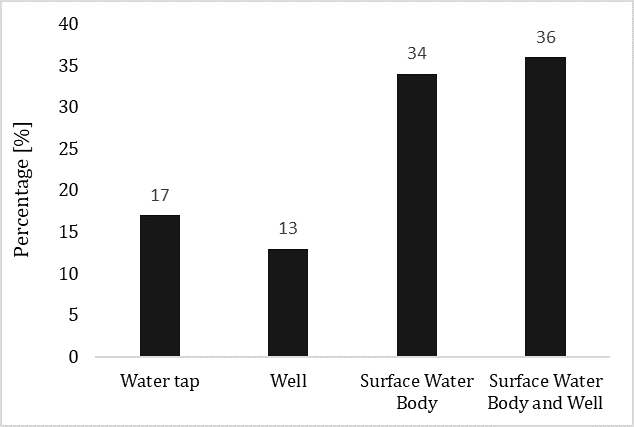
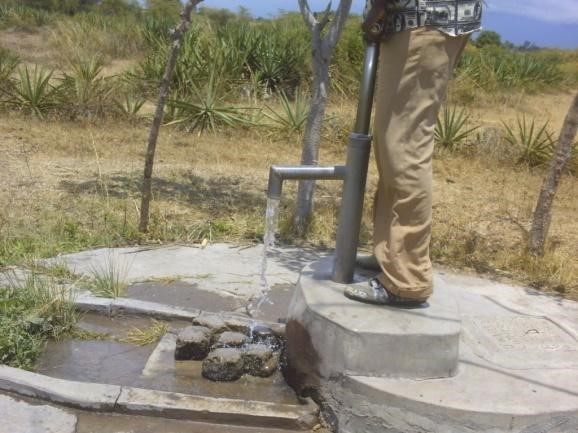
In the project area, an average household has nine family members who consume an average of 23 l/p×d of water. This consumption includes process water and drinking water. Families with more than 15 members consume only 14 l/P×d. Another major problem is the constant illness of stomach pain and diarrhea, 84% of the families stated that they suffered from it regularly. The affected families live exclusively in the suburban villages. The drinking water in particular is not adequately treated here. Only when it contains organic and inorganic foreign matter is it often filtered either through a cloth (60%) or through a tea strainer (28%). 41% of the families surveyed have their drinking water prepared by boiling it, of which 71% also show the symptoms of the disease described. In addition to drinking water treatment, however, hygiene also plays a decisive role. For example, the 16% of families who are not regularly ill wash their hands without exception after going to the toilet. In the entire project area, at least 75% of residents state that they wash their hands regularly after going to the toilet.
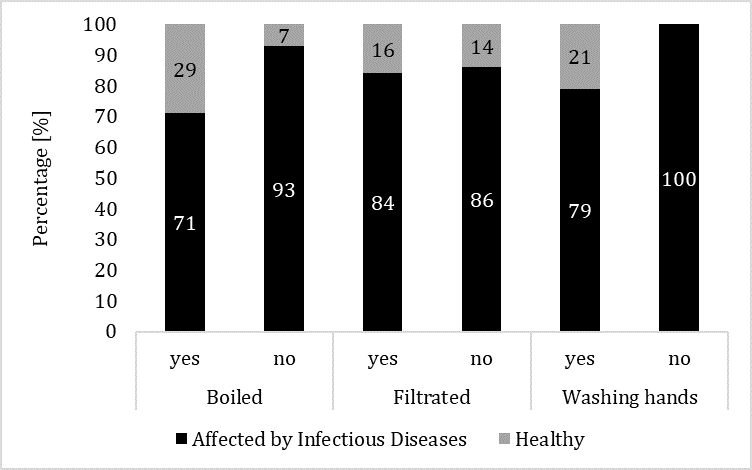
Waste Water Management
87% of the families surveyed stated that they could use a latrine. In Igoma, these are sanitary facilities with a sewer line to a septic tank. The families of the suburban villages have simple latrines as shown in Figure 4. They share this with an average of 11 people. In 13% of all families surveyed, the latrine collapsed and is therefore no longer functional. The simple latrines are covered with organic materials. 63% of the families stated that using them for small children under the age of five is too dangerous.
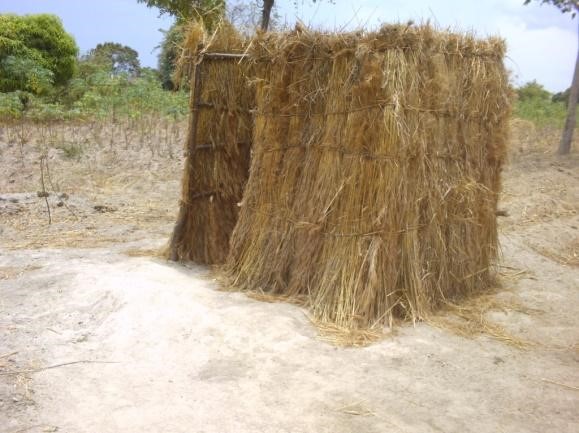
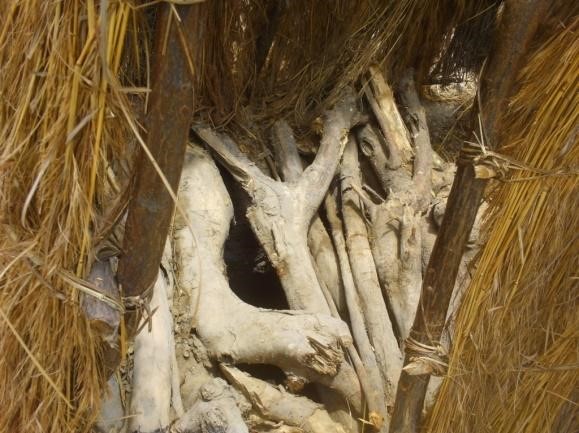
Rainwater Management
Overall, 82% of families use rainwater. Of the 101 families surveyed in the suburban villages, only two have a rainwater cistern. The remaining families put buckets under the roofs, if there is a corrugated iron roof with a gutter, to collect the rainwater. Some use the collected rainwater in the local depressions in the ground. Only 16% of those who use water from precipitation as drinking water treat it. 12% of families irrigate their fields with rainwater.
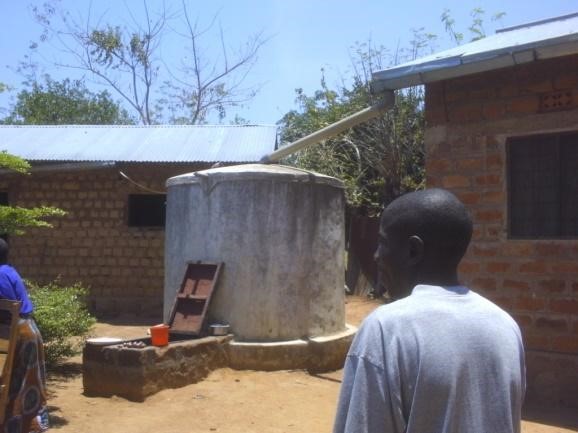
Energy Sources
In the project area, 77% of the families use firewood as an energy source. The remaining 23% of families that mainly use charcoal live in Igoma or Kissesa. The women need an average of three hours a day to procure firewood. 96% of the families use a paraffin lamp as a light source, whereas the families in the suburban villages mainly use lamps with an open flame (see Figure 7). This has already resulted in house fires and several burn injuries to children in 28 % of cases.
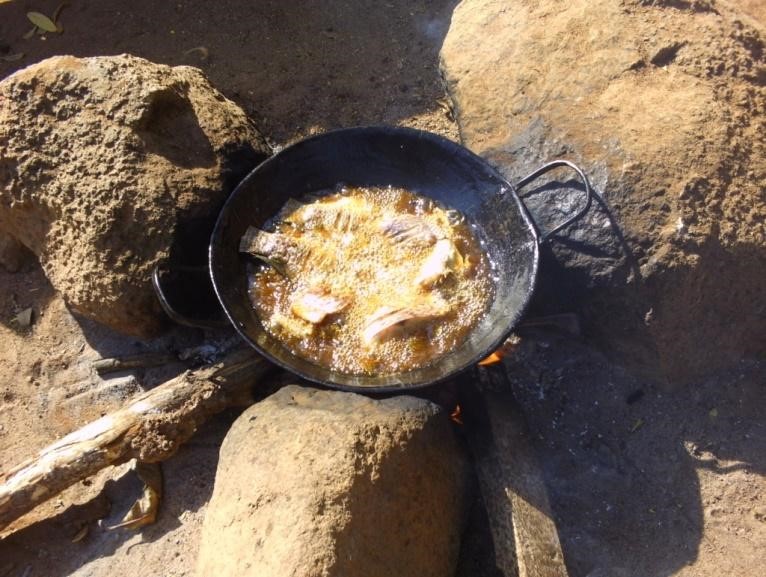
Waste Management
In the densely populated outskirts of Igoma, almost every family owns a private garbage pit. Of the families surveyed, the 36% who said they incinerate their residual waste live almost exclusively in Igoma. The remaining 64% from Ikengele, Ihayabuyaga and Kissesa dispose of their waste outside the huts. This includes batteries in particular, some of which are reused as toys for children. 21% of the organic waste is fed to livestock, otherwise thrown away.
Implementation of Workshops on site in 2011 and 2015
Contact: Jan Osten & Sebastian Schlauss
In the workshops, knowledge was imparted with the help of posters and example objects, such as a sand filter in a glass vessel or microscopes. The main content points were: the groundwater system, the correct use of water as a resource, environmental pollution and the emergence of microorganisms or what consequences microorganisms can have on health. Over time, the training courses have been optimized again and again and new content, such as deforestation including consequences, has been added.
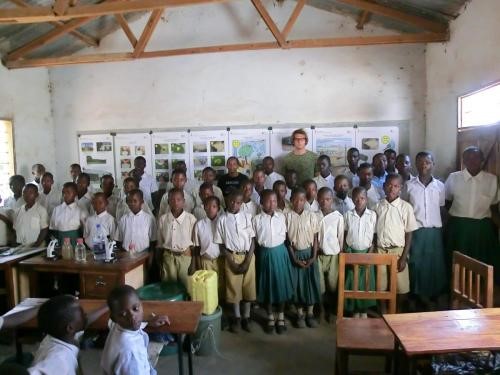
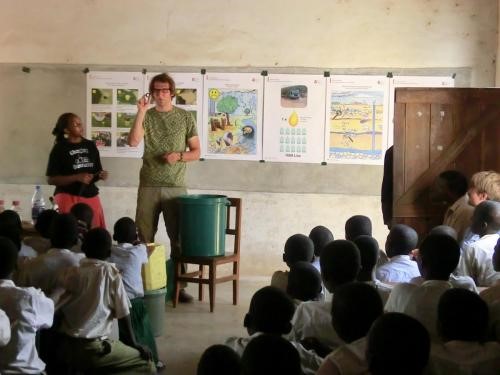
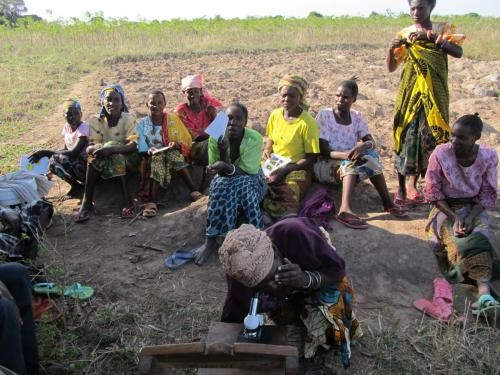
Construction of Clay Cooking Places in 2011 and 2015
Contact: Jan Osten
According to the WHO (who.int), mortality in developing countries from smoke inhalation from cooking is the fifth highest risk. According to estimates, two million people die every year as a result, mainly women and children, who wear them while cooking (Art. Süddeutsche). In addition to the health problems, the traditional three-stone fire and the use of wood or charcoal also pose a resource problem, since the environment and climate are equally affected by the inefficient use of the fuel. During the project, inhabitants of the Mwanza region were shown how to build a clay cooker including a small chimney with simple means. Since the advantages of the clay cooking area are obvious, the residents of the villages in particular have responded very positively to this new method of cooking. The families who cook with firewood very often only use three stones to put a pot on a fire. This not only creates a lot of harmful smoke, this method is also relatively energy-intensive. In total, more than 45 clay cooking areas were built up based on the same principle. The smoke is led outside through a chimney, a fire heats up two pots at the same time. As the name suggests, the clay cooking area is mainly built from clay. Other building materials are sand, water and some mud bricks or bricks. Thus, the required materials are very cheap and easily available for many people. The actual construction of the clay cooking area takes 1-3 days, depending on the air temperature and the duration of the drying phase. After that, it’s possible to use two pots at the same time with one fire. The first pot is in front, over the fire, and a little further behind is the second pot, which is supplied with sufficient heat with the help of a deflection stone. The smoke is discharged through the chimney. The pots are enclosed in clay so that very little smoke can develop inside the room. A stone is also used to close the fire hole in order to store the heat or to only divert the smoke into the chimney.
With this simple design of a cooking place, the villagers have a good alternative to the conventional way of cooking. With the help of the clay cooking area, there is no longer any smoke inside the houses, which means better health, especially for children and women. In addition, people save firewood because the clay cooking area is more effective than the traditional three-stone fire. During the course of the project, the student Mkama was trained more intensively than other villagers in order to be able to build the clay cooking area independently for families in the region. He proved to be a skilled craftsman and continuously and independently spread the knowledge for the construction of a clay cooking area. Within the project period, more than 50 clay cooking places were built together with the respective families. Due to the high acceptance of the villagers, it can be assumed that the clay cooker will continue be used in the future and thus be well integrated into society.
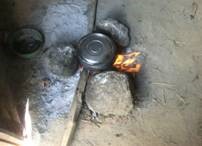
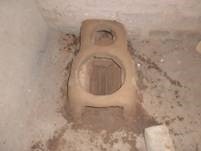
Construction of Drinking Water Wells in 2015
Contact: Sebastian Schlauss
In 2011, a campaign was carried out by the „Basic Needs Team“ at the Lübeck University of Applied Sciences in which the number and location of the existing wells in the area were recorded.
In addition, other possible locations for new wells were identified. As part of a bachelor thesis by Jan Osten, a concept for identifying possible well locations was developed. Furthermore, aspects of drinking water treatment, energy (efficient use of firewood) and educational workshops in the area of hygiene and the environment were processed on site. Consequently, in 2015, a project application for the installation of four more wells in the suburban villages of Ihayabuyaga and Ikengele was also submitted by Luther-Melanchthon KG to BINGO! Environmental lottery provided and approved. In the following, the execution of the boreholes on site is described.
The aim of the project planned for 2015 was to drill and equip four wells in the Igoma region of Tanzania. These wells should be a secure basis for the daily water supply for the population in the rural region. The project was carried out on the basis of an existing cooperation between the Ev.-luth. Congregation Luther-Melanchthon zu Lübeck and the Angaza Congregation, Igoma, Tanzania. The implementation of the work was professionally supported by members of the Laboratory for Urban Water Management and Waste Management at the LSA on a voluntary basis.
Based on the survey from 2011 described in the project application, the offers for drilling and equipping the wells, the inventory of the existing wells in the project area and the approval of the project application by BINGO! – Project funding from June 2015, the work defined in the application could be successfully carried out during the stay on site from mid-July to the end of September 2015.
After the successful installation, the first pumping attempts were made in the presence of a few villagers. After all work was completed, the wells were ceremonially handed over to the water committee and thus to the villagers during a service by the pastor from Igoma. They are now responsible for the operation and possible maintenance of the pump.
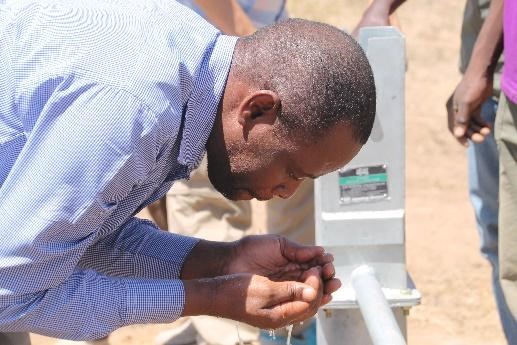
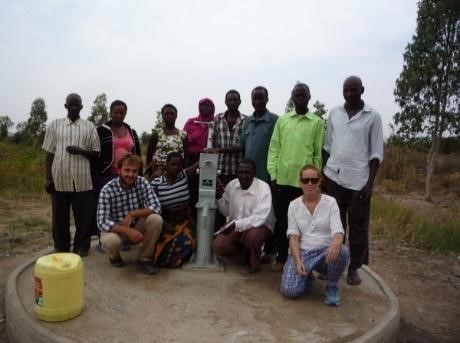
Construction of a Separating Toilet in 2015
Contact: Sebastian Schlauss
The first separation toilet was initially built for demonstration purposes at a school for around 500 students. A latrine that separates urine and solids can be a significant step towards improving agricultural yields. However, the construction of a latrine to use the faeces as fertilizer must be carried out with simultaneous workshops, because this is the only way such a measure can be successfully implemented, as it requires a high level of social acceptance. In a latrine with material flow separation, there are two different openings in the base plate. The urine (yellow water in a can) is collected separately from the solids (brown water in a basket/can) under the latrine. The wastewater that is separated in this way contains different amounts of nutrients (potassium, phosphorus, nitrogen, carbon). These can be applied as valuable fertilizers to the soils of the adjacent fields. Solids are reduced compared to before and can be mixed with animal faeces and organic waste and brought to the fields after composting. The yellow water (urine) can be immediately distributed out of the collection canister on the field. In particularly dry weather, it should be diluted with a small amount of washing water beforehand. In this way, waste water is optimally used and disposed of in a circular economy. First success in the school garden can be seen, where Christina and Glory fertilized three weeks ago with the urine collected at the beginning of the campaign (end of July). More details about this project can be found on Betterplaces.org:
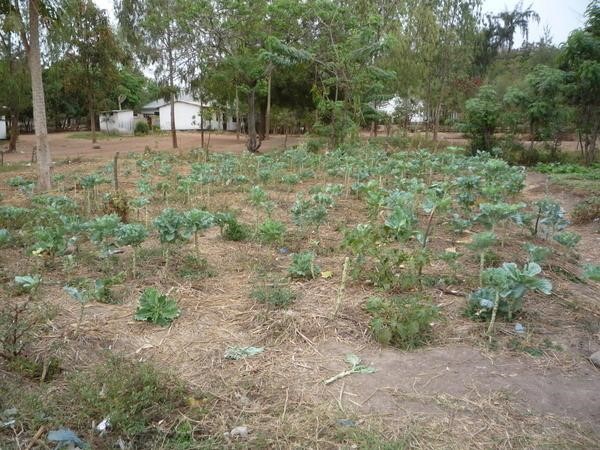
The right half was fertilized with urine, so the plants grew faster.
Water for Malya, 2018-2019
Project partner: Center for Mission and Ecumenism – North Church worldwide (nordkirche-weltweit.de)
What are the consequences of climate change on agriculture in Tanzania? How can people and agriculture adapt to the consequences? – this is shown in the film „Water for Malya“ – a sustainable approach to climate change“. With the „Water for Malya“ project, the East of Lake Victoria diocese in northern Tanzania is countering the consequences of climate change. Together with the Center for Mission and Ecumenism, the Technical University of Lübeck and the Environmental and Climate Protection Office of the North Church, the concept was created on the Malya Farm of the diocese to build a sustainable and reliable water supply for agriculture and the people in the area.
Water for Malya – A sustainable approach to adapt to climate change (long version) – YouTube
Since the land of Malya Farm is regularly supplied with water via a solar pump and a large storage tank via drip irrigation, sowing and harvesting can take place regularly again. The income from the farm increases and can be sold in the local markets. Rainwater collection tanks provide additional water for irrigation. Residents in the area can obtain clean water regularly and free of charge from public taps. The distance to the water source has been reduced from up to three kilometers to 500 m for most households. Reliable irrigation has planted a nursery of 6000 seedlings (mango, lemon, moringa and local varieties such as michongoma and papaya) using water from the main line. Cabbage, amaranth, carrots, okra and sweet potatoes were planted on a one-hectare plot. Another hectare of banana and bean plants, irrigated with the water from the tank, contributes to a great variety of planting. Also, the living fences that surround the fields are only possible through the water access. Elephant grass and brachygrass have been planted around the fields to prevent pests from entering. In total, the farm grounds include an acacia forest with beehives, an orchard, an area for permaculture cultivation, an agricultural area with drip irrigation, an area for seasonal cultivation of corn and rice, and a secondary school for training agricultural professionals. Methods of sustainable agriculture are to be taught practically in this school. This project thus combines practical climate protection and climate adaptation with education for sustainable development.
